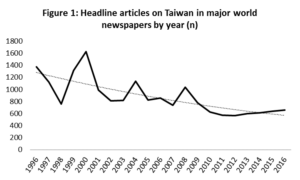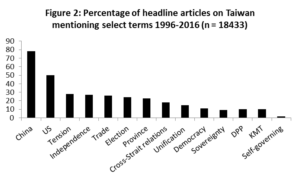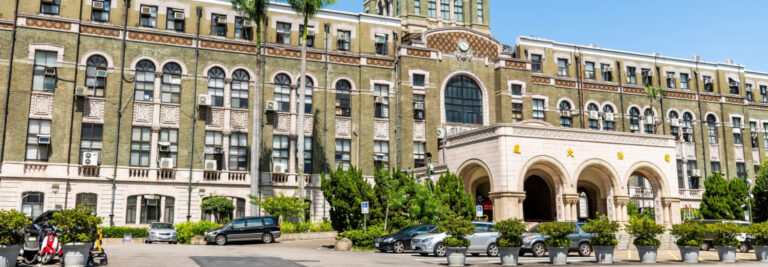When news broke about US President-elect Donald Trump’s call with Tsai Ing-wen, the subjects that most interested the international media were: first, the United States—in the guise of the news-cycle-dominant Trump—and, second, China, and its likely reaction to Trump’s diplomatic faux pas. Pro-Trump analysts viewed the story through the lens of a newly robust US foreign policy towards China. Anti-Trump analysts fretted about the dire consequences of the neophyte leader’s ignorant approach to US-China relations. Taiwan, its government and its people, were at best a footnote; even when it transpired that the call was initiated by Taiwan, the focus remained on the wisdom of Trump accepting the call, his motivations, and how China would react. This treatment is consistent with long term Western media narratives on Taiwan.
In general terms, Taiwan’s efforts to present its own narrative have come up against entrenched framing strategies that privilege Beijing’s rhetorical position. Within a dominant focus on developments in Taiwan through the lens of cross-Strait relations and the broader regional political environment structured by Sino-US relations, these framings frequently connect Taiwan to “tensions” in the Strait. Despite enjoying functional autonomy, reports about Taiwan invariably position it within an implicit ”One- China” framework, where China’s claims to control Taiwan are juxtaposed with subtly “destabilizing” forces within and emanating out of Taiwanese domestic politics. This is evident in frequent depictions of the pursuit of “independence,” notwithstanding the almost complete marginalisation of this position in Taiwan itself.
To check these impressions based on 20 years of studying and reading media reports about Taiwan, I used the Nexis database to locate articles in “major world newspapers” publishing in English that contained “Taiwan” in the headline. I collected all articles between January 1st 1996 and June 30th 2016, the 20-year period that covers what is generally known as “democratic Taiwan.” Preliminary analysis of the document set shows that western media coverage of Taiwan during the past 20 years is substantial. Headline stories on Taiwan generated in excess of 18 thousand articles. By comparison, using the same search parameters, South Korea garnered one third less attention than Taiwan. On average over two decades Taiwan has generated around 900 articles per year.

Measuring select terms that appear in headline articles on Taiwan across the entire 20-year document set confirms the media’s major preoccupations in regard to Taiwan. First and foremost, China is integral to Western media coverage of Taiwan, to the extent that China is referenced in nearly 80 percent of headline articles about Taiwan. To a lesser extent, the United States is also central to coverage of Taiwan, being present in nearly half of headline stories. The pre-eminence of the China lens (including Sino-US relations) in coverage of Taiwan is an obstacle to the dissemination of a distinctly Taiwanese narrative. The frame most often used to deliver news on Taiwan is as a site of “tension, crisis and conflict”—which appears in nearly one third of articles. Furthermore, because China has been so effective in setting the global media understanding of cross-Strait relations, it is often implied that Taiwan is the source of this conflict and tension; an unfortunate irony, given that it is Beijing that reserves the “right” to use force against Taiwan under the anti-secession law and has over 1,500 missiles aimed at the island.

The prevalence of references to “independence” (in one quarter of articles) indicate the major source of potential conflict, a frame that implicitly supports Beijing’s argument that the real status quo is “One China” and that “independence” is illegitimate and dangerous. The fact of Taiwan’s self-governing, functional autonomy is rarely noted, appearing in just over one percent of articles. The democratic achievements that Taiwanese are rightly proud of, and Taipei would like to emphasize as a defining part of its narrative, are mentioned in 11 percent of articles. Elections are mentioned in nearly one quarter of articles, but domestic political competition is again frequently perceived through the lens of generating conflict with China.
In the stories that the international media produce on Taiwan, there is a high degree of consonance with real world events. For instance, presidential election years in Taiwan are associated with greater international media attention and a greater proportion of stories about the election. International media coverage is also sensitive to the changing salience of discourse and policy in Taiwan (and indeed in China). For example, the salience of identity politics and rhetoric that could be interpreted as denoting “independence” did increase during Chen Shui-bian’s tenure, while an increasing emphasis on cooperation and trade were features of Ma Ying-jeou’s administration. These macro-level developments were both reflected in media coverage. In general terms, the media does not create or distort developments in Taiwan, and I do not imply any wrongdoing on the part of media outlets, editors or journalists. However, a preoccupation with certain types of story, and entrenched ways of reporting on Taiwan have resulted in an unbalanced narrative being delivered to Western audiences, with concomitant implications for Taiwan’s national image and the success of its soft power and public diplomacy programs.
One explanation for understanding how the media covers Taiwan lies in the way the media itself works. The process of international news production relies on popular geopolitical frameworks that simplify complex issues for domestic consumption, often through the lens of power politics. Popular geopolitical discourses employ straightforward, explanatory frameworks, providing links between issues in “exotic” locales, where people are often seen as the “other,” and a local audience’s concerns. In the hands of international media concerned with “the big picture,” popular geopolitical framings deal in black and white simplicity, with a focus on crisis and conflict. Preoccupation with these frames is compounded by the fact that many journalists writing about Taiwan are not Taiwan specialists, and financial cuts mean that correspondents often parachute into Taiwan from China or Hong Kong to cover salient events in Taiwan, such as elections, on an ad hoc basis. The lack of permanent, specialized, Taiwan-based correspondents, combined with editorial conventions, shorthand cues, and a general lack of space for stories on Taiwan, do not bode well for challenging established conventions for reporting on Taiwan. Setting aside the issue of increasing Chinese influence, in terms of media ownership and efforts to steer the global narrative, there is little space, capacity, or audience demand, for detailed explanations of the complexities of Taiwan’s situation, making it difficult to challenge the normalization of digestible cues like “independence seeking,” “renegade province,” or “tensions.”
Through the promotion of Taiwan as a stable, open democracy committed to universal liberal values, there is the potential for generating soft power gains as a bulwark against Chinese pressures and support for appropriate participation in international society. To this end, Taiwan has strengthened its state-led public diplomacy and soft power initiatives, but faces an uphill struggle to establish its distinct “national brand,” due to entrenched global media narratives that privilege popular geopolitical frames. Culture—in the sense of exhibitions and exchanges—is rarely “newsworthy,” and Taiwan’s culture-based public diplomacy has failed to gain traction in the foreign media. In order to have more forceful public diplomatic engagement, and to address the issue of geopolitical framing that inadvertently tends to burnish Beijing’s preferred understanding of the status quo, Taipei needs to consider ways of telling its story that are more multidimensional, moving beyond culture. In short, Taipei should acknowledge that Taiwan is viewed through a geopolitical lens and adopt communication strategies that address it.
The main point: Taiwan faces an uphill struggle to establish its distinct “national brand” due to entrenched global media narratives that privilege popular geopolitical frames. By portraying Taiwan through the lens of cross-Strait relations, international media inadvertently propagate PRC claims about the “status quo.”



